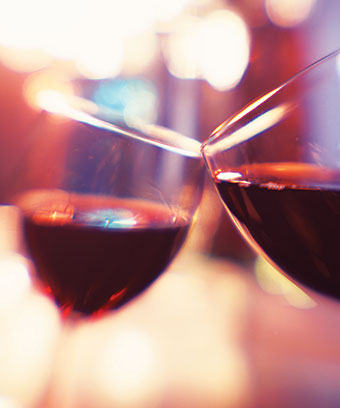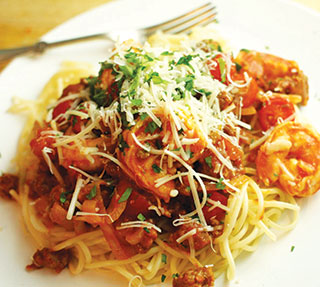A Winey Reminiscence
by Joe George

Cooking with wine is an easy way to liven up a dish and also the person preparing it
Many years ago, when I was an apprentice cook, I was one of a handful working under a chef whom we equally admired and feared. We admired him for his encyclopedic knowledge, leadership, and his interest in his young cooks. He was European and came of age during the Second World War, and regaled us with larger-than-life stories of his youth.
But it didn’t take long to realize that he liked his wine for more than just cooking, and when he drank he was not nearly so admirable. He would add wine by the bottle to large pots of sauce but not before filling a bain marie for himself, which he kept nearby and drank like Kool-Aid throughout the day. Still, he was an inspiration for me. And even though I drink my fair share of wine—sometimes too much, I suppose—it is also because of him that I made the promise to myself not to perpetuate the stereotype of the drunken chef by drinking on the job.
This same chef encouraged me to attend culinary school, and there it was like a veil was lifted and I saw the true art and science of cooking. When I first witnessed a classic wine-based sauce being made, I was amazed. If I recall correctly, it was demi-glace au vin rouge. The chef began with the traditional base of espagnole sauce, and though we only needed enough for a couple dozen customers, he proceeded with two bottles of wine and a half-gallon of veal stock. Thinking he was making an incredibly large amount for so few people, but being too intimidated to question his judgment, I watched in silence.
Throughout the day the wine simmered slowly in one pot and the stock and espagnole sauce simmered in another until a mere fifth of the original remained. As the liquids evaporated, the chef tended to them as if he were nurturing a child. “The sauce makes itself,” he said, “you simply guide it along.” (This is a quote that stays with me to this day, not just with sauce making but with most foods.) He then combined the two liquids in a clean pot and continued to “guide” the sauce for another hour or so. He told us that a superb sauce simply could not be rushed, and that patience was an essential ingredient.
In a divine moment of clarity it all made sense to me. By reducing liquids separately the flavors become concentrated—the water content decreases through evaporation and flavors grow stronger. In the case of a meat-based stock, such as veal, as it reduces, or evaporates, the remaining liquid becomes somewhat viscous, almost syrupy. With wine, not only do the flavors become concentrated, but the harshness of the alcohol dissipates as well.
A few years after that I had the incredible opportunity to study with Madeleine Kammen, the famed author and culinary educator. During one class she showed us how to make an essence of guinea hen. While doing this she instructed us to take a sip of wine and then a spoonful of sauce, and to swirl the liquids across our tongues; after that, we took another sip of the wine. The change in flavor was remarkable; it was much easier to balance the flavors of the sauce with the memory of the wine still on our tongues. When we seemed astonished, Ms. Kamman remarked that winemakers put so much of their lives into their wine that we should give the sauce in which we use their wine at least an equal amount of respect and attention. Somewhat bleary by many sips, we all concurred.
Which wine for the pot?
I find it interesting that wine can be drunk on its own, used as an accompaniment, and also as an ingredient. When added in proper proportions, wine can take a recipe to a new level, but too much of a strongly flavored wine can have the opposite effect. And by strongly flavored I mostly mean fortified wines, such as sherry and port, but also really cheap wines that have an off flavor.
Worse yet are wines labeled as “cooking wines”; these are the lowest of the lot. They are essentially wines not suited for the table and have the addition of salt. Legend has it that the reason salt was added to wine, which would later be categorized as cooking wine, was to keep the cooks from drinking it. But if cooking wine is not suitable to drink, why would it be good as an ingredient?
If you don’t like the flavor of the wine on its own, you probably won’t like it in food either. Said simply, cook with wines that you enjoy.
Wine-making dates back more than 5,000 years, so its relationship with food and cooking—particularly sauce making—is only natural. Not all wine-based sauces need an entire day for production. Take, for example, beurre blanc (French for “white butter”). The fundamentals for this sauce have been around for quite some time, but it was relatively unknown outside the Loire Valley before the early 1960s. When the flourless sauces of cuisine nouveau were all the rage, beurre blanc took Paris, and the rest of the world for that matter, by storm. It’s said to have evolved from a method used in rural France when poaching fish; a pat of butter is swirled into the liquid just before serving.
There are two schools on beurre blanc: with cream or without. Adding cream will stabilize it to a certain extent but purists usually prefer the creamless method. Making beurre blanc is about as simple as sauce making can get. White wine and/or vinegar are simmered, and then chilled butter is swirled in just before serving. The resulting simplicity is both full-flavored and silken on the tongue. Sauces like this, I believe, are nothing short of alchemy.
Another good example of a wine-based sauce, albiet a much heartier one, is fra diavolo. It’s made by quickly simmering red wine, garlic, hot peppers, anchovies, and herbs, then adding tomato; it’s often paired with seafood or pasta. The name, fra diavolo, translates to English as “Brother Devil.” It’s said to have been named after a 17th-century monk who went astray. Apparently he was caught in an uncomfortable circumstance with a local prostitute. After he was expelled from the monastery, his fellow monks created this sauce in his honor. The red wine in the recipe represents that which the monk was drinking during his fall from grace.
For the past decade I’ve cooked in a private city club where many of the recipes are made on a large scale; Sometimes I add wine to a pot by the gallon. And being someone who likes to drink wine, I relish its aroma as it chug-a-lugs out of the bottle and splashes into the pot. Sometimes as I do this I think of the chef from years ago who drank as much wine as he cooked with. But more often these days I think of my late friend and fellow culinarian, Kara, who liked when I swirled the bottle a little as I poured wine into the pot; the wine forms a sort of funnel. She called it a wine tornado…and sometimes it is.
Sherried Mushroom SoupYield: 2 1/4 quarts3 tablespoons butter 1/4 cup diced onion 1/4 cup diced celery 1/4 cup diced carrot 1 pound mushrooms, washed and sliced 1 teaspoon salt 1/2 teaspoon ground black pepper 1/2 cup flour 4 cups chicken broth 2 cups heavy cream 1/2 cup sherry Heat the butter in a small, heavy soup pot over high heat. When the butter begins to bubble, add the onion, celery, and carrot; sauté over for approximately 5 minutes. Add the mushrooms, salt, and pepper; sauté an additional 5 minutes or until the mushroom juice evaporates. Stir in the flour, lower the heat to medium and cook the flour, with the mushroom mixture, for approximately 5 minutes while stirring constantly to prevent scorching. Whisk in the stock, making sure to remove any lumps. Bring the soup to a boil, lower it to a simmer, and cook the soup for 15 minutes. Skim any scum that may rise to the surface. Add the cream, then the sherry; simmer an additional 5 minutes. Pan-Roasted Salmon with Chive Beurre BlancYield: 4 Servings3 tablespoons olive oil 4 portions salmon 1/4 cup white wine 1/4 cup white wine vinegar 1/4 teaspoon salt 1/4 teaspoon white pepper 1/4 minced chives 1/4 pound chilled unsalted butter, cut into cubes thin slices of lemon for garnish Preheat an oven to 350F. Heat the olive oil in an ovenproof skillet over high heat. When the oil is very hot, carefully place the salmon in the skillet, skin-side up. Cook the salmon for a minute or so, until it begins to brown, then turn it over and place the skillet in the oven. Roast the fish for about 7 minutes. In a separate smaller skillet, combine the wine, vinegar, salt, and pepper. Bring to a boil and cook until just a couple tablespoons of liquid remains. Stir in the chives and remove the pan from the heat. Remove the fish from the oven and transfer it to a serving platter. Return the sauce skillet to the heat and swirl in the butter a couple pieces at a time. When the last of the butter is almost melted, pour the sauce over the fish and garnish with lemon slices. |

Shrimp Fra Diavolo
Shrimp Fra DiavoloYield: 4 servings6 tablespoons olive oil, divided 1/2 small onion, diced 2 cloves garlic, minced 2 anchovy filets 1 teaspoon crushed red pepper 2 teaspoons minced parsley 1/2 teaspoon basil 1/2 teaspoon salt 2/3 cup red wine 2 cups tomato purée 1/2 pound linguine 1/2 pound large shrimp, peeled and cleaned Heat 3 tablespoons olive oil in a small sauce pot. Add the onion and garlic; sauté until translucent but not browned. Add the anchovies and hot pepper; sauté for 1 minute, mashing the anchovies with a wooden spoon. Stir in the parsley, basil, salt, and red wine. Simmer the wine for a couple of minutes, then add the tomato puree. Simmer the sauce slowly for about 20 minutes. If the sauce becomes too thick, thin it with a little water. While the sauce is simmering boil the pasta until al dente, rinse it and set aside. Heat the remaining 3 tablespoon oil in a large skillet over high heat. Pat the shrimp dry and carefully add them to the skillet. Stir and toss the shrimp in the hot oil for a minute or two, then add the sauce. Lower the heat to a simmer and cook the shrimp for just a couple minutes. Make sure the pasta is drained well and add it to the sauce. Cook just long enough to reheat the pasta. |
|
Issue Navigation> Issue Index > v10n10 (The Drinking Issue, week of Thursday, March 9) > A Winey Reminiscence This Week's Issue • Artvoice Daily • Artvoice TV • Events Calendar • Classifieds |









 Current Issue
Current Issue